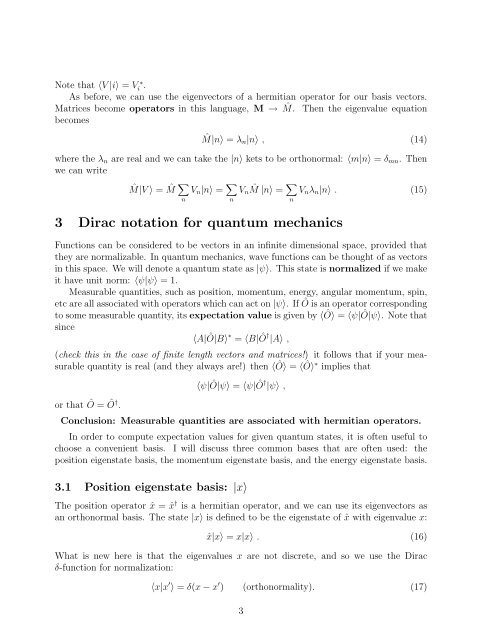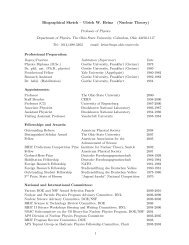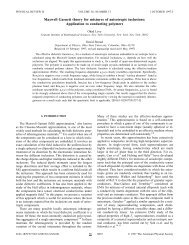Dirac Notation 1 Vectors
Dirac Notation 1 Vectors
Dirac Notation 1 Vectors
Create successful ePaper yourself
Turn your PDF publications into a flip-book with our unique Google optimized e-Paper software.
Note that 〈V |i〉 = V ∗<br />
i .<br />
As before, we can use the eigenvectors of a hermitian operator for our basis vectors.<br />
Matrices become operators in this language, M → ˆM. Then the eigenvalue equation<br />
becomes<br />
ˆM|n〉 = λ n |n〉 , (14)<br />
where the λ n are real and we can take the |n〉 kets to be orthonormal: 〈m|n〉 = δ mn . Then<br />
we can write<br />
ˆM|V 〉 = ˆM ∑ V n |n〉 = ∑ ∑<br />
V n ˆM |n〉 = V n λ n |n〉 . (15)<br />
n<br />
n<br />
n<br />
3 <strong>Dirac</strong> notation for quantum mechanics<br />
Functions can be considered to be vectors in an infinite dimensional space, provided that<br />
they are normalizable. In quantum mechanics, wave functions can be thought of as vectors<br />
in this space. We will denote a quantum state as |ψ〉. This state is normalized if we make<br />
it have unit norm: 〈ψ|ψ〉 =1.<br />
Measurable quantities, such as position, momentum, energy, angular momentum, spin,<br />
etc are all associated with operators which can act on |ψ〉. IfÔ is an operator corresponding<br />
to some measurable quantity, its expectation value is given by 〈Ô〉 = 〈ψ|Ô|ψ〉. Note that<br />
since<br />
〈A|Ô|B〉∗ = 〈B|Ô† |A〉 ,<br />
(check this in the case of finite length vectors and matrices!) it follows that if your measurable<br />
quantity is real (and they always are!) then 〈Ô〉 = 〈Ô〉∗ implies that<br />
〈ψ|Ô|ψ〉 = 〈ψ|Ô† |ψ〉 ,<br />
or that Ô = Ô† .<br />
Conclusion: Measurable quantities are associated with hermitian operators.<br />
In order to compute expectation values for given quantum states, it is often useful to<br />
choose a convenient basis. I will discuss three common bases that are often used: the<br />
position eigenstate basis, the momentum eigenstate basis, and the energy eigenstate basis.<br />
3.1 Position eigenstate basis: |x〉<br />
The position operator ˆx =ˆx † is a hermitian operator, and we can use its eigenvectors as<br />
an orthonormal basis. The state |x〉 is defined to be the eigenstate of ˆx with eigenvalue x:<br />
ˆx|x〉 = x|x〉 . (16)<br />
What is new here is that the eigenvalues x are not discrete, and so we use the <strong>Dirac</strong><br />
δ-function for normalization:<br />
〈x|x ′ 〉 = δ(x − x ′ ) (orthonormality). (17)<br />
3
















